
The labyrinth is a universal symbol that we find in all eras and civilizations, in all aspects of art and in everyday life.
Let us accept for a moment the premise that every human being has, step by step, once he has set out on the path… “walker, there is no path, the path is made by walking…” as Antonio Machado said.
Continuing its journey between interrupted paths, and lines that without beginning or end asked to be made or drawn again.
This is precisely why walking has become a way of encountering the world, the other, or ourselves. We cannot help but be deeply attracted by this new space.

El laberinto es un símbolo universal que encontramos en todas las épocas y civilizaciones. En todos los aspectos de arte y en la vida cotidiana.
Aceptemos por un momento la premisa que paso a paso el ser humano tiene, una vez emprendido el camino”…caminante, no hay camino, se hace camino al andar…” como decía Antonio Machado.
Continuando su recorrido entre senderos interrumpidos, y líneas que sin principios o fin pedían ser hechas o trazadas de nuevo.
Por esto precisamente el andar entonces ha sido una manera para encontrar el mundo, el otro o nosotros mismos. No podemos sino ser profundamente atraídos por este nuevo espacio.
The Labyrinth and its deep symbolism. / El Laberinto y su profunda simbología.
Metaphors are often accurate. In the popular imagination, a labyrinth is similar to a solar system. Or, in other words, to a place where it is very easy to get lost.
And in which finding something turns out to be an extremely complicated task.
When we talk about a labyrinth, in a metaphorical sense, we are referring to a problem that apparently has no solution.

Las metáforas suelen ser, en muchos casos, acertadas. Un laberinto en el imaginario popular se asemeja a un sistema solar. O a lo que es lo mismo, a un lugar en el cuál es muy fácil perderse.
Y en el cuál encontrar algo resulta una tarea sumamente complicada.
Cuando hablamos de laberinto, en un sentido metafórico, nos estamos refiriendo a un problema que no tiene, aparentemente, una solución.
The Mason's Labyrinth. / El Laberinto della Masone.
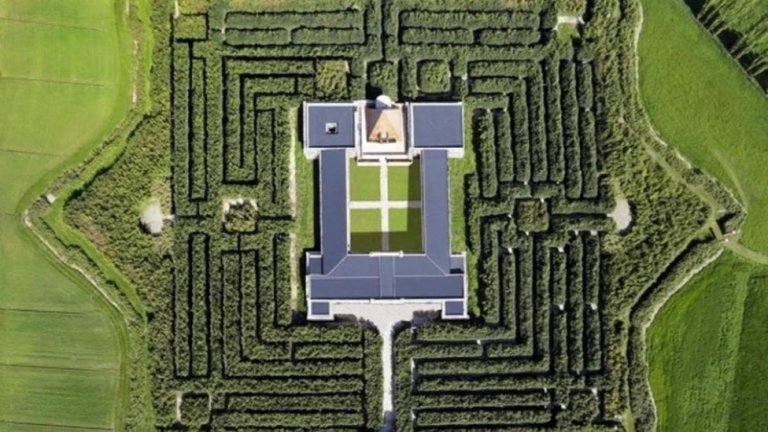
Fontanellato's Labyrinth of the Masons , strongly desired by Franco Maria Ricci , is in fact an allegory of the complexity of the world. A work whose intelligibility cannot be sustained by reason alone.
Hence, the shapes of the same are added, fused and confuse us. From above it looks like a fortress, a pulsating star enclosed by geometries. But from other perspectives it seems and is much more.
Intensely attracted to labyrinths, the Argentine writer Jorge Luis Borges always referred to them, especially when he wanted to reflect in his texts the complexity, the deceptiveness and the challenges of existence.
The Borgesian labyrinth symbolizes the transformative process of human experience, where the traveler is constantly confronted with destruction, but also with the creation of himself.
In 1977, the Italian editor Franco Maria Ricci promised his Argentine literary friend that before he died he would devote himself to the task of building an immense labyrinth, inspired by his aesthetic and narrative conception.

El Laberinto della Masone en Fontanellato, fuertemente deseado por Franco Maria Ricci constituye de hecho una alegoría de la complejidad del mundo. Una obra cuya inteligibilidad no se puede sostener con la unica razón.
De ahí que las formas del mismo se sumen, se fundan y nos confudan. Desde arriba se parece a una fortaleza, una estrella pulsante encerrada por geometrías. Pero desde otras perspectivas parece y es mucho más.
Atraído intensamente por los laberintos el escritor argentino Jorge Luis Borges siempre se remitió a ellos, Especialmente cuando quiso reflejar en sus textos lo complejo, lo engañador y lo desafiante de la existencia.
El laberinto borgeano simboliza el proceso transformador de la experiencia humana. Donde el viajero constantemente se enfrenta a la destrucción. Pero tambien a la creación de sí mismo.
En 1977 el editor italiano Franco Maria Ricci le promete a su amigo literato argentino que antes de morir se entregaría a la tarea de construir un inmenso laberinto, inspirado en su concepción estética y narrativa.
The first labyrinths. / Los primeros laberintos.
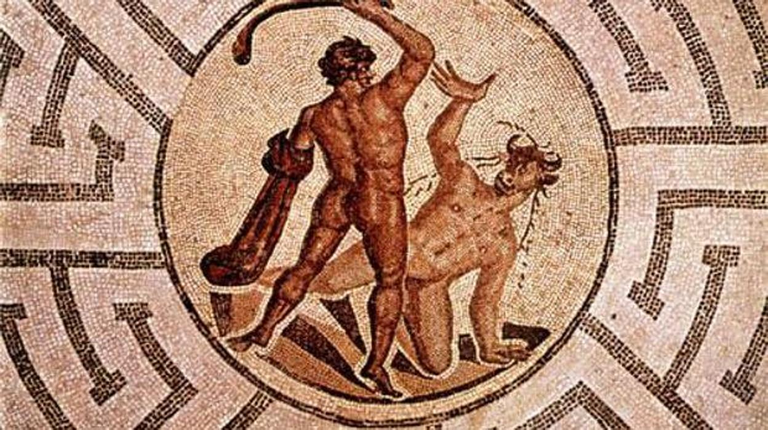
As a first example of a labyrinth, we cannot fail to mention the Cretan Labyrinth and the legend of the Minotaur, a monster that was half man and half bull imprisoned inside it and to whom young victims were offered.
The earliest labyrinth that can be accurately dated is on a clay tablet at Pylos, Greece. Accidentally preserved by the fire that destroyed the palace in 1200 BC, the front of the tablet holds records of goat deliveries to the palace.
The square labyrinth drawn on the reverse is clearly a scribble made by the scribe. It is interesting that this first example is found in the traditional home of King Nestor. The king, together with Menelaus, planned the fleet of ships for the siege and subsequent fall of Troy. This is how Homer relates it in the Iliad.
The depiction of a labyrinth on an Etruscan wine jar from Tragliatella, Italy, dating to the late 7th century BC, shows armed soldiers on horseback, running in front of a labyrinth with the word TRVIA (Troy) inscribed in the outer circuit.

Como primer ejemplo laberíntico no podemos dejar de mencionar el Laberinto de Creta y la leyenda del Minotauro. Un monstruo medio hombre y medio toro encarcelado en su interior al que se le ofrecían víctimas jóvenes.
El primer laberinto que puede ser fechado con exactitud, está en una tablilla de arcilla en Pilos, Grecia. Accidentalmente conservada por el incendio que destruyó el palacio en el año 1200 a. C., la parte delantera de la tablilla de mantiene los registros de las entregas de cabras al palacio.
El laberinto cuadrado dibujado en el reverso es claramente un garabato hecho por el escriba. Es interesante que este primer ejemplo se encuentre en el hogar tradicional del rey Néstor. El rey junto a Menelao planeò la flota de barcos para el asedio y posterior caída de Troya. Asì lo relata Homero en la Ilíada.
La representación de un laberinto en una jarra de vino etrusca de Tragliatella, Italia, que data de finales del siglo séptimo a. C., muestra soldados armados a caballo, corriendo delante de un laberinto con la palabra TRVIA (Troya) inscrita en el circuito exterior.
The symbol of the labyrinth. / El simbolo del laberinto.
The labyrinth symbol was also a popular theme in Roman mosaic pavements.
There are more than 70 examples of them.
Dated from 165 BC to AD 400, they are found throughout the Roman Empire , from Portugal to Cyprus , and from northern England to North Africa .
Many of these mosaics are damaged, but a good number of them have been found intact.

El símbolo del laberinto también fue un tema popular en los pavimentos de mosaico romanos.
Existen más de 70 ejemplos de ellos.
Fechados desde el año 165 aC hasta el 400 dC, se encuentran en todo el Imperio Romano, desde Portugal a Chipre, y desde el norte de Inglaterra a África del Norte.
Muchos de estos mosaicos están dañados, pero un buen número de ellos se han encontrado intactos.
The labyrinth of the mind. / El laberinto de la mente.
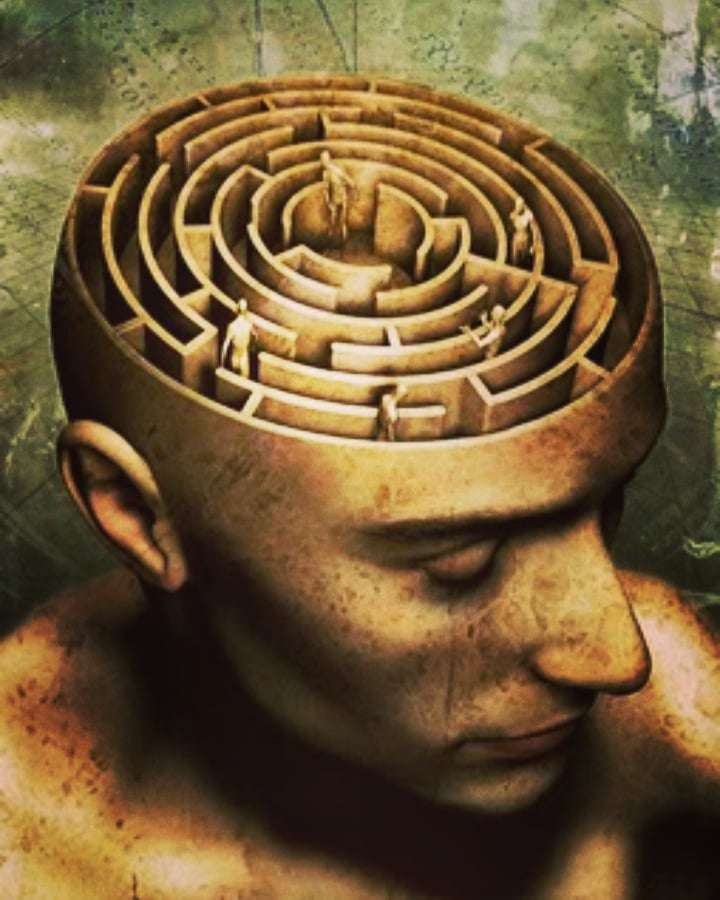
The concept of Labyrinth can also be defined as a labyrinth of the mind or madness.
The figure of Orlando when he manages to escape from the enchanted cave is emblematic in Ariosto's epic poem. The knight, who is a symbol of perfection, loses his mind over a woman when he finds the tree and reads the inscription. He becomes so enraged and mad that he begins to destroy the trees.
In Praise of Folly, Erasmus uses satire in a social and cultural context convulsed by the struggle between medieval tradition and the new premises suggested by humanism. Erasmus creates a seductive and forceful mirage that, imbued with the Christian humanism he advocated, serves as an excuse to describe the foolishness of the world and attack everything human and divine.

El concepto de Laberinto tembién se puede definir como una laberinto de la mente o la locura.
La figura de Orlando cuando logra escapar de la caverna encantada es emblemática en el poema épica de Ariosto. El caballero, que es un símbolo de perfección, pierde el juicio por una mujer al encontrar el árbol y leer la inscripción. Se enfurece y enloquece de tal manera que empieza a destruir los árboles.
En Elogio de la Locura Erasmo usa la sátira en un contexto social y cultural convulsionado por la lucha entre la tradición medieval y las nuevas premisas que apuntaba el humanismo. Erasmo crea un espejismo seductor y contundente que, impregnado del humanismo cristiano que preconizaba, le sirve de excusa para describir la necedad del mundo y arremeter contra todo lo humano y lo divino.
The Labyrinth in Art. / El Laberinto en el Arte.
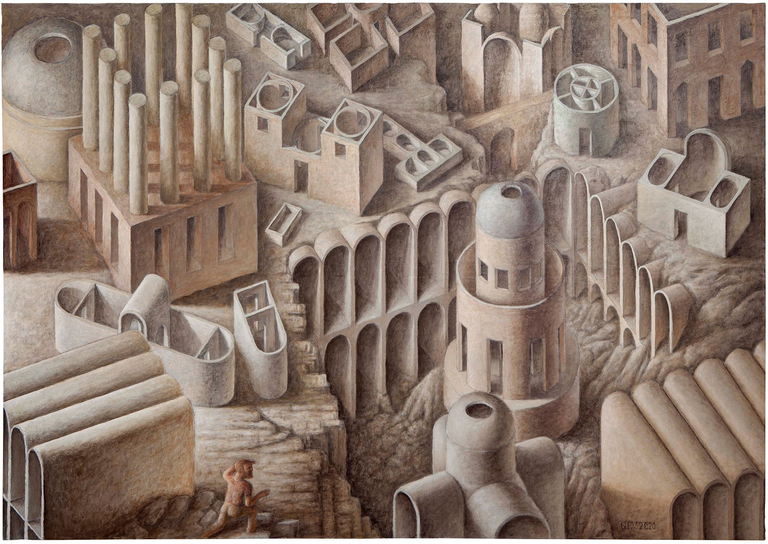
The shape of the labyrinth as a construction and symbol is present in the most varied cultural traditions of humanity, just like the spiral or the cross.
The idea of the labyrinth arises from the depths of the human mind.
Since prehistoric times, man, having lost his animal instinct, has felt fear of nature, perhaps for this reason he engraves labyrinths in stones, trying to represent this restlessness and uncertainty before the unknown paths that open before him.
Throughout the history of art and in various periods and movements, labyrinths have been used as artistic elements in works of art. An example of this in surrealism are the works of Remedios Varo and Leonora Carrington, whose iconography served as inspiration for the architectural design of Edward James' Labyrinth in Xilitla, San Luis Potosí, Mexico.
A contemporary artist who develops labyrinths in his installations is Motoi Yamamoto, who, through the design of his works and the connection with salt, a funerary material linked to his culture, elaborates the process of mourning for the loss of his sister, due to brain cancer.

La forma del laberinto como construcción y símbolo está presente en las más variadas tradiciones culturales de la humanidad, igual que la espiral o la cruz.
La idea del laberinto surge de lo más profundo de la mente humana.
Desde la prehistoria el hombre, una vez perdido su instinto animal, siente temor ante la naturaleza, quizá por ello graba laberintos en las piedras, tratando de representar esa inquietud e incertidumbre ante los caminos desconocidos que se abren ante él.
A lo largo de la historia del arte y en épocas y corrientes diversas, los laberintos han sido utilizados como elementos artísticos en obras de arte, ejemplo de esto en el surrealismo, son las obras de Remedios Varo y Leonora Carrington, cuya iconografía sirvió de inspiración para el diseño arquitectónico de Laberinto de Edward James, en Xilitla, San Luis Potosí, México.
Un artista contemporáneo que desarrolla laberintos en sus instalaciones es Motoi Yamamoto, quien a partir del diseño de sus obras y la conexión con la sal, material funerario vinculado a su cultura, elabora el proceso de duelo por la pérdida de su hermana, debida a cáncer de cerebro.
The Labyrinth in the Cinema. / El Laberinto en el Cine.
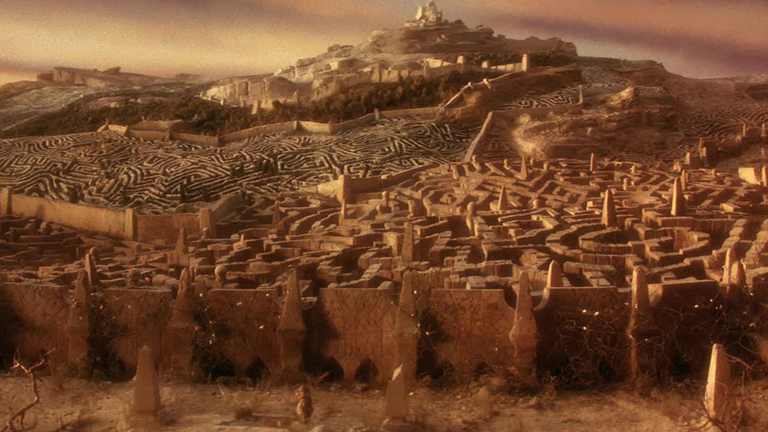
The labyrinth is one of the oldest symbols of what has come to be called our unconscious. It has been sculpted, painted, engraved on walls, on vases, on the ground around villages. Almost everywhere, from Greece to Finland, from Ireland to Tierra del Fuego.
It also appears in the oldest myths, legends, modern tales and current films of all peoples.
And there are many labyrinths in the history of mankind. From the classic one on the island of Crete, to the Egyptian one described by Herodotus, or the labyrinth house in Pompeii and Nauplia, to the Christian and medieval ones in the cathedrals of Chartres and Reims.
Those of so many Renaissance palaces, the Venetian prisons of Piranesi, those of the botanical engineering of Versailles, and even the Kafkaesque and bureaucratic ones of the films of Welles, Hitchcock and Kubrick.
We could say, like Asterion in Borges' story, that "the house (the labyrinth) is the size of the world, or rather, it is the world."
Labyrinths have a special charm. Whether it is due to their enigmatic nature, their implicit meaning or their intriguing beauty. A mix of danger and elaborate designs, labyrinths continue to fascinate, captivate and are a constant reference in fiction.

El laberinto es uno de los más antiguos símbolos de lo que se ha dado en llamar nuestro inconsciente. Ha sido esculpido, pintado, grabado en los muros, en los vasos, en la tierra alrededor de las aldeas. En casi todas partes, desde Grecia hasta Finlandia, desde Irlanda a Tierra del Fuego.
Figura también en los más antiguos mitos, leyendas, en los cuentos modernos y en los actuales films de todos los pueblos.
Y muchos son los laberintos en la historia de la humanidad. Desde el clásico de la isla de Creta, hasta el egipcio que describió Herodoto. O la casa del laberinto de Pompeya y el de Nauplia, hasta los cristianos y medievales de las catedrales de Chartres y Reims.
Los de tantos palacios renacentistas, las cárceles venecianas de Piranesi. Los de la ingeniería botánica de Versalles hasta los kafkianos y burocráticos de los films de Welles, Hitchcock o Kubrick.
Podríamos afirmar como Asterión en el cuento de Borges, que “la casa (el laberinto) es del tamaño del mundo, mejor dicho es el mundo”.
Los laberintos tienen un encanto especial. Ya sea por su carácter enigmático, por su significado implícito o por su intrigante belleza. Mezcla de peligro y diseños elaborados, los laberintos siguen fascinando, cautivando, y son constante referencia en la ficción.
The Labyrinth in Literature. / El Laberinto en la Literatura.
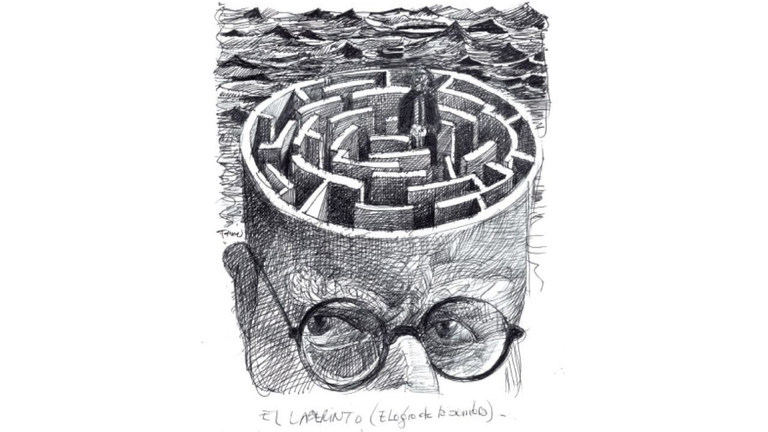
Writers of all ages have also used the labyrinth as a device to structure their creations. Several world works have used labyrinths as such, such as the one in Crete, or something less elaborate, such as a garden with crossroads and forks.
Even from a more symbolic point of view, the work itself could have a tangled and chaotic narrative thread similar to a labyrinth. Today we are going to talk a little about that. And we are going to review the most important appearances of this mythical element.
Every labyrinth, like a home designed for men to get lost in, involves a series of unified places, paths that branch out monotonously. Sometimes a different sign appears and other times, whoever follows it discovers that he is, once again, at the initial starting point.

Escritores de todas las épocas también han recurrido al laberinto como artilugio para estructurar sus creaciones. Varias obras mundiales han utilizado laberintos propiamente dichos como el de Creta. O algo menos elaborado como un jardín con entrecrucijadas y bifurcaciones.
Incluso, desde un punto de vista más simbólico, la obra misma podría tener un hilo de narración enredado y caótico similar a un laberinto. Hoy vamos a hablar un poquito de eso. Y vamos a hacer un repaso por las apariciones más importantes de este mítico elemento.
Todo laberinto, como hogar diseñado para que los hombres se pierdan, supone una serie de lugares unificados. De sendas que se ramifican con monotonía. A veces aparece algún signo distinto y otras quien lo sigue descubre que está, otra vez, en el punto de partida inicial.
he labyrinth as a magical game. / El laberinto como juego mágico.
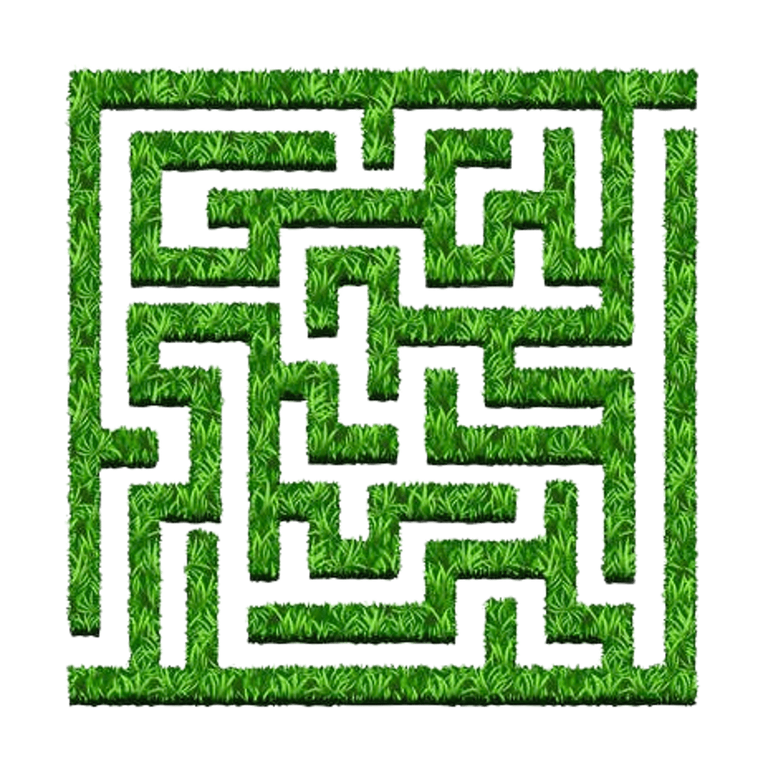
This is a question that invites us to participate in a game where there is always a magical element. The possibility of finding a new twist around a corridor… Or finding ourselves lost in an endless spiral.
Some authors are more “literal” like the living chess that JK Rowling proposes in the first part, or the magical labyrinth in the fourth book. While for others, the meaning is existential. As examples we could mention the destiny of man (always uncertain) with his dreams and ideals, or the journey to intricately wonderful lands to which Lewis Carroll invites us.
The adventures of medieval knights are also labyrinthine. In search of formidable legends, such as the quest for the Holy Grail. Or the unwavering desire to remove the sword stuck in the stone. The epic fantasy of traveling across battlefields to defeat a chaotic and perverse evil is often also labyrinthine.
The immortal Borges is known to have been obsessed with the concept of labyrinths as well as mirrors. He used them repeatedly in the development of his plot.

Esta es una cuestión que nos invita a participar de un juego donde existe siempre un elemento mágico. La posibilidad de encontrar una nueva vuelta de tuerca al doblar un pasillo… O encontrarse perdido en una espiral interminable.
Algunos autores son más “literales” como el ajedrez viviente que nos propone JK Rowling en su primera parte. O el laberinto mágico del cuarto libro. Mientras que, para otros, el significado es de tipo existencial. Como ejemplos podríamos mencionar el destino del hombre (siempre incierto) con sus sueños e ideales. O el viaje hacia tierras enredadamente maravillosas al que nos invita Lewis Carroll.
Laberínticas son también las aventuras de los caballeros de la edad media. En busca de leyendas formidables como la búsqueda del Santo Grial. O también el deseo imperturbable de remover la espada clavada en la piedra. Con frecuencia, también es laberíntica la fantasía épica de recorrer campos de batalla para vencer a un mal caótico y perverso.
Se sabe que el inmortal Borges estuvo obsesionado con el concepto de los laberintos así como también de los espejos. Y lo utilizó repetidas veces en el desarrollo de su trama.
Se sabe que el inmortal Borges estuvo obsesionado con el concepto de los laberintos.
The Labyrinth in Music. / El Laberinto en la Música.
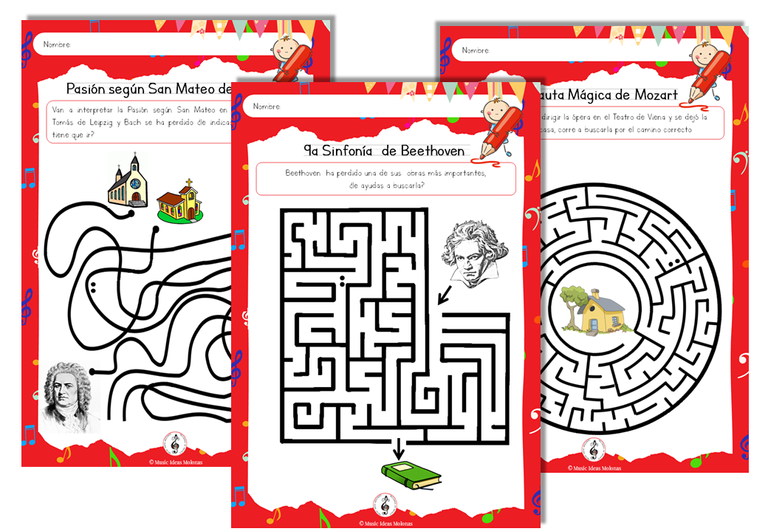
A labyrinthine dance appears to have been brought to Britain from the eastern Mediterranean by Neolithic farmers in the third millennium BC.
Rough stone labyrinths, analogous to the British ones made on turf, occur in the "Beaker B" area of Scandinavia and north-east Russia. In south-east Europe, ecclesiastical labyrinths, once used for penitential purposes, are found.
The oldest known examples of labyrinths are small, simple petroglyphs 3,000 years old. They are found in numerous places around the world, from Syria to Ireland.
Spiral dances, in which young people of both sexes spiralled towards and away from a centre, remained popular in the 19th century, and the labyrinthine dances still practised in Europe are descended from the ancient Crane Dance, or geranos, supposedly performed on the Greek island of Naxos by Theseus and his friends to celebrate their victory.

Una danza laberíntica parece haber sido llevada a Britania desde el Mediterráneo oriental por agricultores neolíticos del tercer milenio a. C.
Toscos laberintos de piedra, análogos a los británicos hechos en el césped, se dan en la zona «Beaker B» de Escandinavia y el nordeste de Rusia. En el sudeste de Europa se encuentran laberintos eclesiásticos, utilizados en otro tiempo con propósitos penitenciales.
Los ejemplos conocidos más antiguos de los laberintos son pequeños y simples petroglifos antiguos de 3000 años. Se encuentran en numerosos lugares alrededor del mundo, desde Siria hasta Irlanda.
Las danzas en espiral, en las que los jóvenes de ambos sexos giraban en espiral hacia un centro para alejarse después, seguían siendo muy populares en el siglo XIX, las danzas laberínticas que aún se practican en Europa descienden del antiguo baile de la Grulla, o geranos, supuestamente ejecutado en la isla griega de Naxos por Teseo y sus amigos para celebrar su salida victoriosa.
The labyrinth in everyday life./ El laberinto en la vida cotidiana.
The Labyrinth can also be interpreted as an everyday challenge within our lives. The labyrinth within family life is a recurring theme. A metaphor for a society in which it is difficult to integrate due to prejudices between people and the differences in culture that may exist.
A labyrinth of different ideas in which each of us must find his own space, winning the challenge of a frenetic and exhausting life. Calvino within the “ Invisible Cities ” introduces this concept with irony. He describes an empty space in which the protagonist must find something that he cannot see, touch and perceive.
The city of Penthesilea is the symbol of our world. A world in which we live every day and of which we know every little part, even its simplest and most essential aspects.
Then questions about life arise, wondering which path is the most appropriate to follow, to avoid falling into normality and boredom.
The only thing that can help us get out of this labyrinth is our reason, but we do not realize that many times, in the labyrinth of everyday life, we return to the starting point.
SEPARADOR
El Laberinto también puede ser interpretado como un desafío cotidiano dentro de nuestra vida. El laberinto dentro de la vida familiar es un tema recurrente. Una metáfora de una sociedad en la que es difícil integrarse debido a los prejuicios entre las personas y la diferencia de cultura que pueda existir.
Un laberinto de ideas diferentes en el que cada uno de nosotros debe encontrar su propio espacio, ganando el desafío de una vida frenética y agotadora. Calvino dentro de las “Ciudades Invisibles” introduce este concepto con ironía. Describe un espacio vacío en el que el protagonista debe encontrar algo que no puede ver, tocar y percibir.
La ciudad de Pentesilea es el símbolo de nuestro mundo. Un mundo en el que vivimos todos los dìas y del cuál conocemos cada pequeña parte, incluso sus aspectos simples y esenciales.
Entones surjen preguntas sobre la vida preguntándose que camino es el más adecuado para seguir. Para evitar caer en la normalidad y el aburrimiento.
Lo único que puede ayudarnos a salir de este laberinto es nuestra razón, pero no nos damos cuenta de que muchas veces, en el laberinto de la vida cotidiana, volvemos al punto de partida.